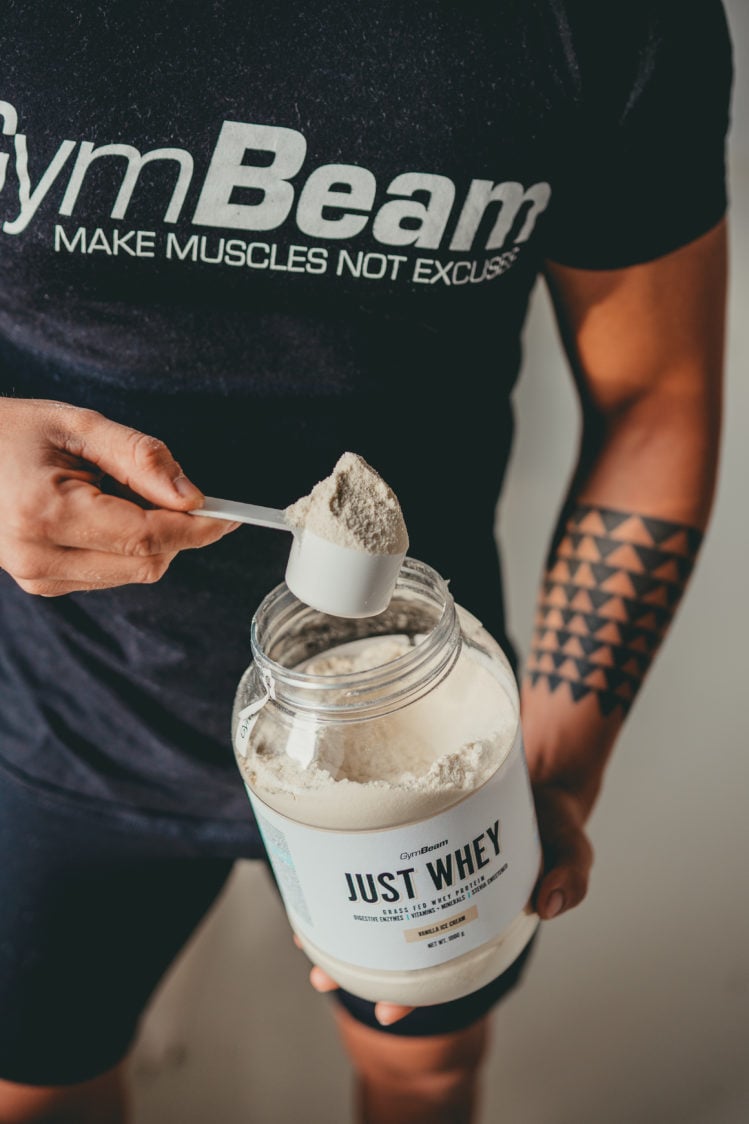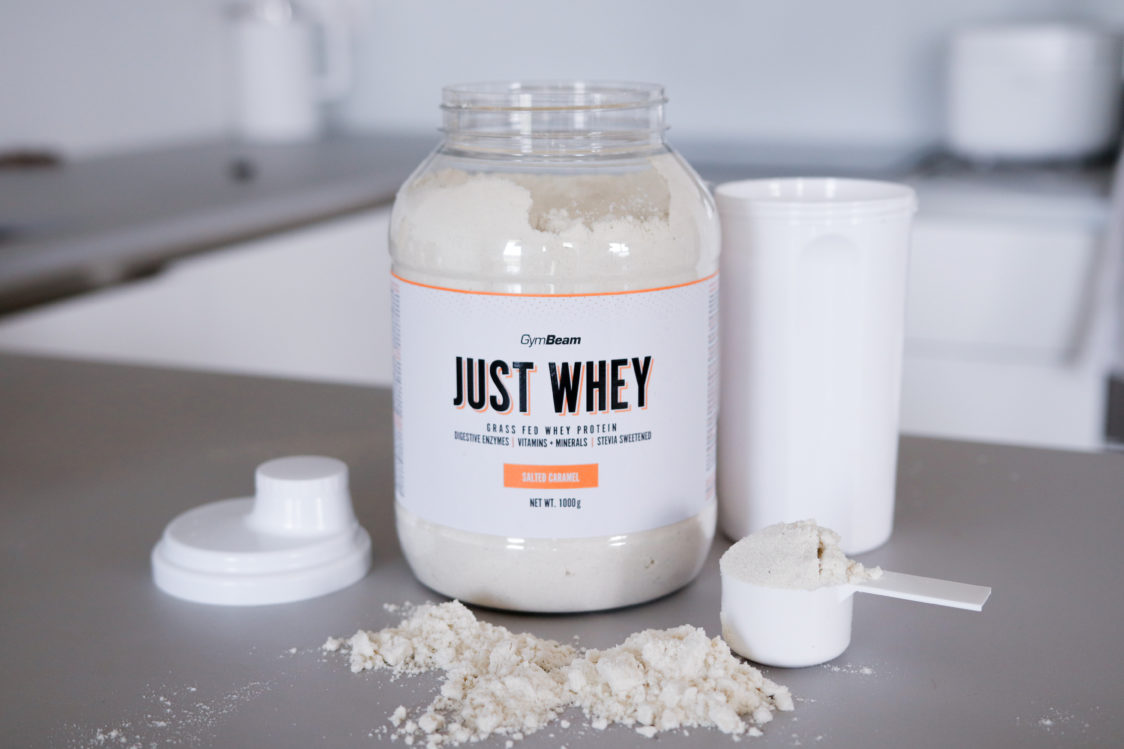Table of Contents
Whey protein powder is commonly regarded as the most popular. And no wonder. It is a great source of protein that has an excellent spectrum of amino acids. What’s more, it’s also one of the best value for money. When you are ready to reach for whey protein, you may be surprised by the vast selection. Suddenly you see concentrate, isolate or even hydrolysate on offer. It’s a challenge, isn’t it? Just because it says Whey on the label doesn’t mean it’s the best protein for you. We’re going to try to help you make your choice today. We’ll tell you how these proteins are made, what the differences are between them, and give you advice on which type is best in which situation.
What exactly is whey protein and what does it contain?
Whey protein can be thought of as a concentrated source of protein that comes from cow’s milk. Basically, it’s what’s left of the milk when you remove all but the whey protein from it. By filtering it, you get rid of the casein protein, water and some of the fat, as well as the lactose. The different types of protein then differ from each other according to the level of filtration or hydrolysis and the proportion of protein and other components contained. Similarly, the proportion of individual amino acids varies slightly.
For a better idea of the amino acid content, we have created a table in which you can find their specific amounts. These are values created by averaging several different whey concentrates. For other types of whey protein, such as isolates and hydrolysates, the amino acid content will generally be higher. This is because filtration and other processes remove a proportion of fat and lactose from the whey concentrate, thereby increasing the proportion of amino acids. [1-3]
Amino Acid | Quantity of amino acid in 100g of whey protein | Quantity of amino acid in 30g of whey protein |
|---|---|---|
| Isoleucine | 49.7 – 57.3 mg/g | 14.9 – 17.2 mg/g |
| Leucine | 79.8 – 106.6 mg/g | 23.9 – 32 mg/g |
| Valine | 18.4 – 59.3 mg/g | 5.5 – 17.8 mg/g |
| Lysine | 76.1 – 88.1 mg/g | 22.8 – 26.4 mg/g |
| Methionine and cysteine | 79.7 mg/g | 23.9 mg/g |
| Phenylalanine and tyrosine | 58.2 mg/g | 17.5 mg/g |
| Threonine | 61.1 – 67.7 mg/g | 18.3 – 20.3 mg/g |
| Tryptophan | 17.3 mg/g | 5.2 mg/g |
| Histidine | 7.8 – 18.7 mg/g | 2.3 – 5.6 mg/g |
| Alanine | 42.1 – 55.5 mg/g | 12.6 – 16.6 mg/g |
| Arginine | 22.0 – 27.1 mg/g | 6.6 – 8.1 mg/g |
| Glutamine | 141.4 – 158.4 mg/g | 42.4 – 47.5 mg/g |
| Glycine | 13.8 – 53.2 mg/g | 4.1 – 16 mg/g |
| Proline | 46.7 – 66.6 mg/g | 14 – 20 mg/g |
| Serine | 38.8 – 53 mg/g | 11.6 – 15.9 mg/g |
| Aspartic acid | 94.1 mg/g | 28.2 mg/g |
The final nutrition profile is also influenced by what you drink it with. If you want to find out which liquid is best to mix protein with, you shouldn’t miss our article Is It Better to Drink Protein with Water or Milk?

How is whey protein made?
Whey protein is made from milk. It contains 20% whey and 80% casein protein. For the record, to make 1 kg of whey protein, you need approximately 100 litres of cow’s milk. A more detailed picture of the production process will help give you a better idea. [4-5]
1. Sourcing whey
To produce whey protein, you first need to obtain the whey. Imagine it as a kind of greenish-yellow liquid. It is 94% water and the remaining 6% is dry matter. The dry matter itself consists mainly of lactose (about 77%), 10% of proteins and the remainder of non-protein nitrogenous and mineral substances or lipids. It is obtained from cow’s milk by coagulation. [32-35]
2. Processing whey
In order to process the whey further, it must be treated first. In this process, the casein protein residues and much of the fat are removed to prevent clogging of the filter membranes. Another important step is pasteurisation (short-term heating), which kills unwanted organisms and deactivates certain enzymes. Some minerals that could have a negative effect on the process are also partially removed. The whey that has been treated in this way must then be concentrated by evaporation. [32-35]
3. Making whey protein
The basic raw material for the production of protein powder is concentrated whey, which has been stripped of casein proteins and partly of fat, lactose and minerals during processing. In order to produce a quality protein from whey, it must undergo gentle filtration. The level of filtration is graded according to how much the pore size of the filter membranes is reduced. [32-35]
The steps of filtration in the production of whey protein
- microfiltration (the lowest level, which is the least costly and so is used most often), within which we distinguish two types of filtration: cross-flow or CFM (which is also used in ultrafiltration) and dead-end
- ultrafiltration
- nanofiltration
- reverse osmosis (the highest level of filtration)
The quality and price of the resulting protein depends on the filtration method used.
You might be interested in these products:
The 7 main benefits of whey protein
Although protein is perceived by many as just a supplement for those who desire big muscles, this is definitely by no means the case. Its benefits can be experienced by people on a diet, those looking to lose weight, or older individuals seeking a musculoskeletal boost. Let’s take a look at the main benefits.
1. Acceleration of metabolism
The increase in metabolism can be attributed to the thermic effect of protein, which has the highest of all macronutrients.
The thermic effect of macronutrients:
- Protein: 20-30%, meaning that out of 100 kcal ingested as protein, the body uses approximately 70-80 kcal.
- Carbohydrates: 5-10%, meaning that out of 100 kcal ingested as carbohydrates, the body uses approximately 90-95 kcal.
- Fat: 0-3%, meaning that out of 100 kcal ingested as fat, the body uses approximately 97-100 kcal.
This simply means that our body uses the most energy of all the macronutrients to metabolise protein. Thus, by consuming them, you burn more energy practically for free, which makes it easier to lose weight. If you consume 150g of protein per day, you can burn up to 180 kcal of additional energy. [6-8]
Protein is not only found in protein powder. You can find other sources in our article Foods that Make It Easy to Add Protein to Your Diet.
2. Losing and maintaining weight
It really makes a difference if your body is 25 or 45% muscle mass. Your energy expenditure at the same weight but different body composition will be different. Muscle mass uses more energy compared to fat mass. The higher the proportion of muscle you have, the more calories you burn in sport and at rest. This is something that can be put to great use, especially when losing weight. In fact, consuming protein powder in combination with strength training can help you build and maintain muscle.
When losing weight in particular, you will also appreciate the fact that protein has the highest satiating power of all the macronutrients. You will feel more satisfied after a complex meal with an ample amount of protein. [9-11]
If you want to learn more about how protein can help with weight loss and how to choose the most effective one, you shouldn’t miss our article How to Choose the Best Protein Powder for Weight Loss?
And, equally, you might find our article How Protein Changes a Woman’s Body and Helps Lose Weight? useful.

3. Growth and maintenance of muscles
This point is surely anticipated by all those who long for a big biceps and a back on which a Boeing 747 could land. The proteins in protein powder are essential for building muscle mass. In addition, whey protein also helps with the maintenance of already developed muscles, which you will appreciate especially when dieting. When your energy intake is lower, your body tends to reach into its own reserves and use them as a source of energy. And nobody wants to lose their hard-earned muscle. To make the most of protein’s potential, it’s ideal to add in strength training, without which muscles won’t grow. [12-13]
4. Improved regeneration
Do you wonder why others at the gym reach for their protein shake practically right after their workout? Because they are not naive and they don’t expect to miraculously gain muscles. The main reason is the ability of protein to start the regeneration of training-damaged muscle fibres almost immediately. And since the body uses protein to repair damaged tissues, together with an optimal protein intake, it can be a great help even after an injury, when a person is trying to get in shape as soon as possible. [14-15]
5. Supports immunity
You may be surprised to learn that proteins are also crucial for the production of immune cells such as white blood cells. Their intake is therefore essential for our immunity. And you will also have heard that the intestines are crucial for our immunity. Therefore, you will be pleased to know that quality whey protein contains alpha and beta-lactoglobulin or lactoferrin, which are beneficial for our intestinal immune function. With that being said, having enough protein in your diet is a great way to support your overall health. [16]

6. Decrease in appetite and cravings
Are you one of the unfortunate ones who are haunted by cravings for sweet and salty treats from morning till night, and on top of that, you are also tormented by stomach grumbling? A poorly structured diet with a lack of protein could be to blame. It is this macronutrient that has the highest satiating power and thus helps to ensure satisfaction from eating. Optimal protein intake can also help reduce levels of ghrelin, which is also known as the hunger hormone. As a result, this further highlights the ability of protein to control hunger and cravings. [17-20]
For more tips to help you get your hunger and cravings under control, read our article How to Get Rid of Constant Hunger and Cravings?
7. Supports bone health
This point will please both active and older people who have difficulties with their musculoskeletal system. In addition to muscle mass, protein also helps maintain healthy bones. According to studies, they can even help prevent fractures and the development of osteoporosis to some extent. Regular physical activity, an optimal protein intake combined with sufficient calcium, vitamin K and vitamin D appear to be effective in promoting bone health. This just confirms the fact that getting enough protein, even in the form of whey protein, is important at any age. [21-23] [36-37]
If you want to learn more about the benefits of whey protein, then you should not miss out on our article Whey Protein and its Effect on Muscle Growth, Weight Loss and Health.
Types of whey protein
There is not only one type of whey protein. There are three basic types of whey protein, depending on the various differences in production and final ingredients profile:
- Whey concentrate (WPC – Whey Protein Concentrate)
- Whey isolate (WPI – Whey Protein Isolate)
- Whey hydrolysate (WPH – Whey Protein Hydrolysate)
A specific group are also multi-ingredient whey proteins, which are a mix of selected or all the types of whey proteins. In order to be able to choose the protein that is ideal for you in relation to your goals, let’s break down each type in more detail.
1. Whey concentrate (WPC – Whey Protein Concentrate)
Whey concentrate ranks as one of the leaders in popularity. This is mainly due to its excellent price/performance ratio and versatile use. If you don’t use protein yet and are looking for your first ever one, whey concentrate is a great choice.
How is whey concentrate made?
Whey concentrate, like all other whey proteins, is made from whey obtained from milk. Previously, for example, the ion exchange method was used for processing, which was relatively cheap but not very gentle on the protein. This resulted in the degradation of protein fractions such as alpha – lactoglobulin, lactoferrin and the like. Today, therefore, more gentle filtration methods are preferred. These include, the aforementioned microfiltration, nanofiltration and ultrafiltration. Thanks to these, the protein retains a significantly higher proportion of beneficial substances and you can get the most out of it. In addition, the resulting powder is flavoured in various ways. If you don’t fancy the unflavoured option, you can choose from chocolate, vanilla, salted caramel, banana and countless other flavours. There’s a flavour for just about everyone. [24]
How much protein does whey protein concentrate contain?
The range of protein content in whey concentrate is very broad. Most often you will probably encounter 70-80%. However, there are also concentrates available that contain significantly less. For example, you can also find concentrates with only 35% protein content. Since it should be used primarily a source of protein, it is ideal to reach for one that has, for example, around 75% of this macronutrient.
How rapidly is whey protein concentrate absorbed?
Whey concentrate is absorbed relatively quickly, at a rate of approximately 10 g per hour. [31]

For whom and when is whey concentrate suitable?
- Athletes who want to build muscle.
- Strength athletes after training to support recovery.
- Strength training athletes at any time of the day to satisfy optimal protein intake.
- Endurance and other athletes after training to promote regeneration.
- Endurance athletes at any time of the day to satisfy optimal protein intake.
- For those trying to lose weight.
- People wanting to reduce their sugar cravings and hunger.
- Anyone who needs to increase their protein intake.
- For all the cooking enthusiasts who want to increase the protein content of their dishes.
- Those in recovery after an injury.
- Anyone who wants to provide their body with high quality, affordable protein powder.
What are the benefits of whey concentrate?
- Of all the whey proteins, it is usually the most affordable.
- It is extremely versatile, so it can be used in many ways. You can drink it in the form of a beverage, add it to food and so forth.
- It can be included in the diet of those who are trying to gain muscle, as well as people who are interested in losing weight.
- It has a great taste. Compared to whey hydrolysate, for example, it is not bitter, and if you choose your favourite flavour, you will definitely be more than satisfied.
What are some of the disadvantages of whey concentrate?
- Of all the whey proteins, the concentrate is the most basic form, which may not suit everyone. However, it is still one of the premium proteins and will definitely become a functional part of your diet.
- It contains lactose and may be poorly digestible for some people.
- For some the downside may be that it usually has a slightly higher fat and sugar content than isolate and hydrolysate.
2. Whey isolate (WPI – Whey Protein Isolate)
Whey isolate is like the improved cousin of whey concentrate. It has a “cleaner” ingredients profile, which is characterised, for example, by a minimal lactose content. This is avoided by many people for various reasons. It is thus a protein that is usually sought after by athletes who are in need of more than the normal standard. However, it is definitely great for those who want a high quality first time around.
How is whey isolate made?
Whey isolate is basically produced in the same way as whey concentrate. However, there are more processes. The resulting whey concentrate is further processed through an additional filtration step.
This produces a protein that has a higher isolated protein content than the original concentrate, but a lower sugar and fat content. The filtration process also removes a large proportion of lactose. On average, it contains around 2 g of lactose per 100 g. This makes it a high quality protein that is suitable for the most demanding of consumers as well as people who have problems digesting milk sugars. [25-27]
How much protein is found in whey protein isolate?
Whey isolate typically has a higher protein content compared to whey concentrate. It is typically 80% or more.
How rapidly is whey isolate absorbed?
The absorption rate is similar to that of whey concentrate. It is around 10 g per hour. It is thus a relatively rapid absorbing protein powder. [31]

For whom and when is whey isolate suitable?
- Athletes training under strenuous conditions who are looking to start recovery quickly.
- Fitness and bodybuilding competitors who watch every gram of fat and sugar in their diet.
- People on a weight loss and maintenance diet who don’t want to ingest unnecessary sugar and fat.
- People who want the ultimate weight loss protein with the lowest fat and sugar content.
- Individuals who cannot digest lactose.
- People who are looking for the cleanest concentrated protein source.
What are the benefits of whey isolate?
- It has a very high protein content (up around 90%).
- It will satisfy even the most demanding consumers.
- It is generally low in fat and sugar.
- It is also suitable for those with a lactose intolerance.
- Due to the higher protein content, there is no need to use as high a dose as with whey concentrate with a lower protein content. The protein has a longer life for the user.
What is a disadvantage of whey isolate?
- Compared to whey concentrate, it is usually more expensive.
3. Whey hydrolysate (WPH – Whey Protein Hydrolysate)
You may also know whey hydrolysate by the name “whey hydro”. However, this has nothing to do with hydration or anything like that. The name is derived from the specific manufacturing process that produces a high quality and highly absorbable protein.
How is whey hydrolysate made?
Whey hydrolysate is created by further processing whey concentrate or isolate, specifically through the process of hydrolysis. This is done by adding ingredients to the initial protein that enzymatically split the protein chains into shorter peptides. These are more easily absorbed by the body than proteins composed of long chains of amino acids. This can benefit, for example, athletes after training who want to start the recovery processes as quickly as possible. This may be because they have another training session scheduled that day.
On hydrolysates, you will also commonly see the DH (Degree of Hydrolysis) designation, which also includes a number. This tells you how much the protein has been split. The higher the number, the more bonds have been split and therefore the faster the protein is digested. To give you an idea of what values to go for – the highest possible degree of hydrolysis is called DH32. If you come across such a protein, you can be sure that it is the most absorbable choice. However, you may also come across DH5, for example, where the percentage of split bonds is lower. Because of the splitting, hydrolysate is usually a good alternative for those who are allergic to cow’s milk protein. This is because when hydrolysed, it loses its potential to cause an allergic reaction. [28-30] [38]
How much protein does whey hydrolysate contain?
Whey hydrolysate typically contains around 70-85% protein.

How rapidly is whey hydrolysate absorbed?
Whey hydrolysate stands out among the whey proteins for its excellent absorption rate. It is generally at a rate of more than 10 g per hour. The degree of hydrolysis, for example, has an influence on the specific absorption rate.
For whom and when is whey hydrolysate most suitable?
- For athletes training under extreme conditions who are seeking maximum recovery.
- Demanding consumers who want an even faster absorption rate from their protein.
- Anyone who wants to give their body premium quality protein as quickly as possible.
- For people who are lactose intolerant (suitable if the protein is made from whey isolate).
- For those who have an allergy to cow’s milk protein.
What are some of the benefits of whey hydrolysate?
- It is highly absorbable.
- It can practically initiate recovery processes immediately after exercise.
- As a rule, it is also suitable for people who are lactose intolerant or allergic to cow’s milk protein. However, it must be a hydrolysate that is made from whey isolate.
What are some of the disadvantages of whey hydrolysate?
- Compared to whey concentrate and isolate, it is usually more expensive.
- It has a distinctive taste that is slightly bitter, which can be unpleasant for some.
What is a multi-ingredient whey protein?
If you’ve been in the protein world for a while, you may have noticed that there is a multi-ingredient whey protein. As the name suggests, it’s a combination of several or all of the types of whey protein we’ve discussed above. This creates a protein that combines the properties of specific types, both the positive and negative ones. Therefore, you should always consider whether a multi-ingredient protein is a better choice for you.
If you want further information on how to choose a protein, even plant-based one, you should not miss out on our article How to Choose the Right Protein for Weight Loss or Muscle Growth?
How do you take whey protein?
For whey protein, a dose of 0.25 – 0.3 g per kg of body weight is usually recommended. However, if you don’t want to bother with the maths, you won’t go wrong if you treat yourself to 20 – 40 g of protein. This more or less corresponds to a full 30 g scoop. The upper limit of 40 g of protein is especially appreciated by athletes after a gruelling full-body strength training, when the body’s demand for protein is even higher. If you are interested in the recommended dosage for a particular protein you have at home, you can typically find it on the label. [39]
And if you don’t want to supplement your protein only in the form of a protein drink, then you should also give protein-packed bars a chance. Find out how to choose the best bar in our article How to Choose a Good Protein Bar?

How do you choose the right whey protein for your goal?
Goal | Type |
|---|---|
| Weight loss | Whey concentrate, whey isolate, whey hydrolysate, multi-ingredient whey protein |
| Muscle growth | Whey concentrate, whey isolate, whey hydrolysate, multi-ingredient whey protein |
| Post-workout (general) | Whey concentrate |
| Post-workout (fastest recovery) | Whey hydrolase |
| Enriching meals, cooking and baking with protein | Whey concentrate |
| Lactose intolerance | Whey isolate (or whey hydrolysate made from isolate) |
| Cow’s milk protein allergy | Whey hydrolase |
| Quick snack | Whey concentrate, whey isolate, multi-ingredient whey protein |
What should you remember?
As you can see, there’s no one-size-fits-all protein powder that’s perfect for every person. We all have different requirements. For some, the main criterion when selecting a protein is the price, for others the taste and others will not allow for anything but the highest quality. That is why in today’s article, we have broken down the different types of whey protein in detail so that you will be able to decide for yourself which one will be the perfect one for you, given your goals.
And if you have someone in your circle of friends who chooses whey protein powders according to their packaging because they don’t know their way around them, don’t forget to share our article with them.
[1] Mikael Nilsson et al. – Metabolic effects of amino acid mixtures and whey protein in healthy subjects: studies using glucose-equivalent drinks – https://pubmed.ncbi.nlm.nih.gov/17413098/
[2] Séverin Sindayikengera, Wen-shui Xia, Nutritional evaluation of caseins and whey proteins and their hydrolysates from Protamex – https://pubmed.ncbi.nlm.nih.gov/16421963/
[3] Whey Protein – https://examine.com/supplements/whey-protein/
[4] Hanne B Jensen et al. – Comparative proteomic analysis of casein and whey as prepared by chymosin-induced separation, isoelectric precipitation or ultracentrifugation – https://pubmed.ncbi.nlm.nih.gov/22998726/
[5] Phil Kelly Manufacture of Whey Protein Products – https://www.researchgate.net/publication/330046067_Manufacture_of_Whey_Protein_Products
[6] Thermic Effect of Food – https://examine.com/topics/thermic-effect-of-food/
[7] James Hill, Wyatt, H. R., & Peters, J. C. – The Importance of Energy Balance – https://doi.org/10.17925/EE.2013.09.02.111
[8] G W Reed, J O Hill - Measuring the thermic effect of food – https://pubmed.ncbi.nlm.nih.gov/8561055/
[9] Kim J. et al. – Effects of dietary protein intake on body composition changes after weight loss in older adults: A systematic review and meta-analysis. – https://doi.org/10.1093/nutrit/nuv065
[10] Westerterp-Plantenga, M. S., Lejeune et al. – High protein intake sustains weight maintenance after body weight loss in humans. – https://doi.org/10.1038/sj.ijo.0802461
[11] Waliłko, E. et al. – High-Protein or Low Glycemic Index Diet—Which Energy-Restricted Diet Is Better to Start a Weight Loss Program? – https://doi.org/10.3390/nu13041086
[12] John D Bosse et al. – Dietary protein to maximize resistance training: a review and examination of protein spread and change theories – https://pubmed.ncbi.nlm.nih.gov/22958314/
[13] Eric R Helms et al. – A systematic review of dietary protein during caloric restriction in resistance trained lean athletes: a case for higher intakes – https://pubmed.ncbi.nlm.nih.gov/24092765/
[14] L Russell et al. – The importance of patients' nutritional status in wound healing – https://pubmed.ncbi.nlm.nih.gov/12070399/
[15] David Frankenfield – Energy expenditure and protein requirements after traumatic injury – https://pubmed.ncbi.nlm.nih.gov/16998142/
[16] Beaulieu, J. et al. – Whey proteins and peptides: Beneficial effects on immune health – https://doi.org/10.2217/14750708.3.1.69
[17] Pesta et al. – A high-protein diet for reducing body fat: Mechanisms and possible caveats. – https://doi.org/10.1186/1743-7075-11-53
[18] Halton et al. – The effects of high protein diets on thermogenesis, satiety and weight loss: A critical review. – https://www.ncbi.nlm.nih.gov/books/NBK70804/
[19] Wendy AM Blom et al. – Effect of a high-protein breakfast on the postprandial ghrelin response – https://academic.oup.com/ajcn/article/83/2/211/4649849?login=true
[20] Manuela P G M Lejeune et al. – Ghrelin and glucagon-like peptide 1 concentrations, 24-h satiety, and energy and substrate metabolism during a high-protein diet and measured in a respiration chamber – https://pubmed.ncbi.nlm.nih.gov/16400055/
[21] Jean-Philippe Bonjour – Dietary protein: an essential nutrient for bone health – https://pubmed.ncbi.nlm.nih.gov/16373952/
[22] Marian T. Hannan et al. – Effect of Dietary Protein on Bone Loss in Elderly Men and Women: The Framingham Osteoporosis Study – https://asbmr.onlinelibrary.wiley.com/doi/full/10.1359/jbmr.2000.15.12.2504
[23] Commission Regulation (EU) No 432/2012 of 16 May 2012 establishing a list of permitted health claims made on foods, other than those referring to the reduction of disease risk and to children’s development and health – http://data.europa.eu/eli/reg/2012/432/oj
[24] WHEY PROCESSING – https://dairyprocessinghandbook.tetrapak.com/chapter/whey-processing
[25] C. V. Morr et al. – Whey protein concentrates and isolates: Processing and functional properties – https://www.tandfonline.com/doi/abs/10.1080/10408399309527643
[26] Nissim Silanikove et al. –The Interrelationships between Lactose Intolerance and the Modern Dairy Industry: Global Perspectives in Evolutional and Historical Backgrounds – https://www.mdpi.com/2072-6643/7/9/5340/htm
[27] Cross Flow Microfiltration is considered the gold standard approach to producing whey protein – https://www.glanbianutritionals.com/en/nutri-knowledge-center/innovative-technology/cross-flow-microfiltration-cfm
[28] Shane M Rutherfurd Methodology for Determining Degree of Hydrolysis of Proteins in Hydrolysates: A Review – https://academic.oup.com/jaoac/article/93/5/1515/5655787
[29] RhichaSinha – Whey protein hydrolysate: Functional properties, nutritional quality and utilization in beverage formulation – https://www.sciencedirect.com/science/article/abs/pii/S0308814606003050?casa_token=iURxfPjthXcAAAAA:T5aVEauJtBK9N2Y93tSmzaNpnvjHk6xnDUigTDQevx52QKAa55v_DV1AerwlNjQq_xcVzyk0iQ
[30] Zhi-jie Bao et al. – Effects of degree of hydrolysis (DH) on the functional properties of egg yolk hydrolysate with alcalase – https://www.ncbi.nlm.nih.gov/pmc/articles/PMC5334225/
[31] Brad Jon Schoenfeld at. – How much protein can the body use in a single meal for muscle-building? Implications for daily protein distribution – https://www.ncbi.nlm.nih.gov/pmc/articles/PMC5828430/
[32] Pieter Walstra et al. – Dairy Science and Technology – https://www.taylorfrancis.com/books/mono/10.1201/9781420028010/dairy-science-technology-walstra-pieter-walstra-jan-wouters-tom-geurts
[33] Kadlec Pavel et al. – Technologie potravin: Co byste měli vědět o výrobě potravin
[34] Šustová K. et al. – Mlékárenské technologie
[35] Suková Irena – Syrovátka v potravinářství.
[36] Ballard, T. L at al. – Effect of protein supplementation during a 6-mo strength and conditioning program on insulin-like growth factor I and markers of bone turnover in young adults. The American Journal of Clinical Nutrition
[37] Bonjour, J.P. – Dietary protein: an essential nutrient for bone health. Journal of the American College of Nutrition.
[38] Giampietro, P.G. et al. – Hypoallergenicity of an extensively hydrolyzed whey formula. Pediatric Allergy and Immunology: Official Publication of the European Society of Pediatric Allergy and Immunology.
[39] Ralf Jäger et al. – International Society of Sports Nutrition Position Stand: protein and exercise – https://jissn.biomedcentral.com/articles/10.1186/s12970-017-0177-8


Add a comment